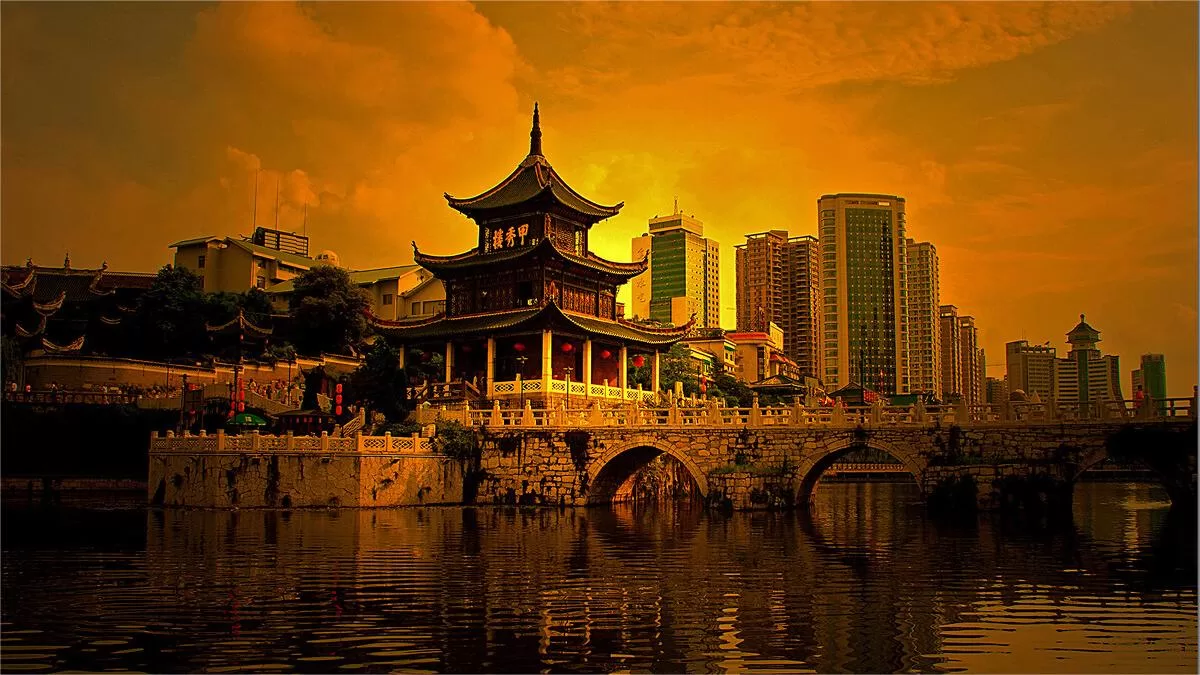Jiaxiu Pavilion (甲秀楼, Jiaxiu Tower), situated on the Nanming River in Guiyang, was initially constructed in the 26th year of the Wanli era in the Ming Dynasty (1598). Its name, meaning “outstanding scholars,” reflects its significance. Built upon a massive riverside boulder, the pavilion underwent multiple renovations over the ages, with the current structure dating back to a reconstruction in the first year of the Xuantong era in the Qing Dynasty (1909). A must-visit for tourists in Guiyang, Jiaxiu Pavilion offers breathtaking night views, enhancing its allure as a picturesque destination. Adjacent to the pavilion stands the Cuiwei Garden, also constructed during the Ming Dynasty, which visitors can explore alongside the pavilion.
The three-story pavilion, made with white stone balustrades and rising in tiers, reaches a height of 22.9 meters. The Nanming River flows in front of the pavilion, converging into the serene Huanbi Pool. Connecting the pavilion’s side, the “Floating Jade Bridge,” an arched stone bridge, links both shores, leading to a small pavilion called the “HuanbiPavilion.” The pavilion itself showcases a traditional architectural style, characterized by vermilion beams, green tiles, three stories with three eaves, and four corners topped with pointed roofs. Jiaxiu Pavilion stands as a splendid architectural gem, harmonizing with the natural beauty of its riverside setting.
Table of Contents
- Basic Information
- Location and Transportation
- Highlights of Jiaxiu Pavilion
- Vlog about Jiaxiu Pavilion
- Useful Tips Summarized from Reviews
- Attractions near Jiaxiu Pavilion
Basic Information
| Estimated Length of Tour | 0.5 – 1 hour |
| Ticket Price | Free |
| Opening Hours | 9..00 – 18.00; Last admission: 17.30 Closed on Mondays |
| Telephone Number | 0086-0851-85503811 |
Location and Transportation
Jiaxiu Pavilion is situated at No. 8, Cuiwei Lane, Nanming District, Guiyang City, Guizhou Province, China. It stands proudly on the banks of the Nanming River, adding to the picturesque charm of its location.
To get there, tourists can take bus 15, 34, 46, 48, 52, 61, 249, 264, or 307 and get off at Jiaxiulou Stop (甲秀楼站).
Highlights of Jiaxiu Pavilion
Inscription Banner
Adorning the front of Jiaxiu Pavilion are three elegantly inscribed characters, “甲秀楼” (Jiaxiu Pavilion). Crafted during the Qing Xuantong era, these characters were originally penned by the scholar Xie Shiqin. Unfortunately, the original inscription was lost during the Cultural Revolution. However, two recovered pieces, engraved with the characters “秀” (elegance) and “楼” (pavilion), were located, and efforts were made to recreate the missing character “甲” (outstanding) to restore the banner to its original form.
Iron Pillars
The presence of two iron pillars in front of Jiaxiu Pavilion carries historical significance. The first pillar, erected in the fourth year of the Qing Yongzheng era (1726), commemorates Governor E Le Tai’s suppression of the Miao rebellion in Guzhou (modern-day Rongjiang). The second pillar, from the second year of the Qing Jiaqing era (1797), commemorates Governor Le Bao’s suppression of the Bouyei rebellion in Xingyi. Both pillars, adorned with inscriptions, are now preserved at the Guizhou Provincial Museum.
Couplets and Poetry
Jiaxiu Pavilion has been a haven for countless scholars and poets over the centuries, leaving behind an array of praised poems and couplets. Among them, Liu Yushan’s 206-character long couplet stands out, eloquently summarizing the geographical features and historical transformations of the mountainous city of Guiyang.
Cuiwei Garden
Nestled near Jiaxiu Pavilion, Cuiming Garden boasts expansive ancient architecture covering an area of over 4,000 square meters. Its origins trace back to the Ming Xuande era (1426-1435), and the garden was initially a combination of temples and scenic landscapes. Renovated in recent years as Cuiwei Garden, it seamlessly integrates temple architecture with lush courtyards and serene landscapes, creating a harmonious blend of the sacred and the scenic. Notably, the Nan’an Monastery, visited by the philosopher Wang Yangming, was located within these grounds, adding an extra layer of historical significance to Cuiwei Garden.
Vlog about Jiaxiu Pavilion
Useful Tips Summarized from Reviews
Best Time to Visit: The best time to visit is from 18:00 to 22:30, especially for enjoying the night scenery when the lights are on (usually around 19:30). Take a leisurely stroll around Jiaxiu Pavilion, Cuiming Garden, and walk across Fuyu Bridge while enjoying the evening breeze from Nanming River.
Nearby Shopping Areas: If you’re interested in exploring nearby shopping districts, you can head to Lixing Pedestrian Street, which is about 500 meters away, or Hengte Pedestrian Street, which is approximately 800 meters away. These areas offer a variety of shops and boutiques for shopping enthusiasts.
Local Cuisine: When it comes to dining options, you can explore the alleys opposite Jiaxiu Pavilion, as well as Nan Heng Street and Huguo Road. These areas are known for their local delicacies and street food stalls where you can savor authentic flavors of Guiyang cuisine.











The attraction isn’t very large; you can explore it completely in about 30 minutes. Across the street, there’s a cafe called “Shrub Cafe” (灌木咖啡), which is popular among many visitors looking to take a break.
I went to see the night view, and it was quite average. If you’re short on time as a traveler, you can skip this attraction altogether. Just looking at pictures will suffice.
There are many delicious foods in this area. If you walk towards Fushui North Road (富水北路), after crossing the traffic light, you’ll find Quanlin Pedestrian Street, which is full of tasty snacks.
At night, the Jiaxiu Tower is illuminated with dazzling lights, making it truly beautiful. Its location is very convenient, with direct access to several bus routes nearby, and there are plenty of great eating spots around. Huguo Road, Caijia Street, Minsheng Road, and Qingyun Market are all in close proximity, making it a wonderful area to explore. During the day, the Jiaxiu Tower is much less crowded. The interior is not very large, and about half an hour is enough… Read more »
Aside from the building in the middle, there’s nothing else here. I don’t understand what’s attracting so many people—there were crowds on the bridge and the road, making it impossible to move. I took a few pictures by the riverbank but didn’t dare to venture further.
Around 8 PM, I went to see the night view at Jiaxiu Tower. The entrance was crowded with people, as it’s one of the most popular tourist spots currently. You don’t actually have to go inside; instead, you can take the stairs down on the left side and view it from a distance by the lake. There are fewer people here, and the photography results are much better.
Jiaxiu Tower looks more beautiful at night when it is all lit up compared to during the day. It gets very crowded with people. It’s recommended to book a taxi in advance as there are long queues due to the large number of visitors.
Jiaxiu Tower Route Reference: To see Jiaxiu Tower during the day, you can take a taxi first and take some photos! You cannot enter the Jiaxiu Tower itself, but you can visit Cuiwei Garden next to it during the day! On weekends, there will be traditional Chinese opera performances in Cuiwei Garden, so if you are interested, you can make a reservation in advance. After visiting these two places, right next to Jiaxiu Tower is the Guizhou Ethnic Museum. After… Read more »
If you have plenty of time, you can take a leisurely stroll through the Cuiwei Lane and maybe catch a glimpse of cats climbing the walls. You can also take a seat at the teahouse in Cuiwei Courtyard and enjoy the view of Jiaxiu Tower in the sunlight.
After finally coming to Guiyang, you must visit Jiaxiu Tower (甲秀楼). There are different opinions on whether you should visit during the day or at night. From personal experience, I suggest that if you have time, you can go in the late afternoon and stay until nightfall when the lights are on. Both the daytime and nighttime views of Jiaxiu Tower are worth seeing. However, if you are short on time, it’s better to go after the lights are on.… Read more »